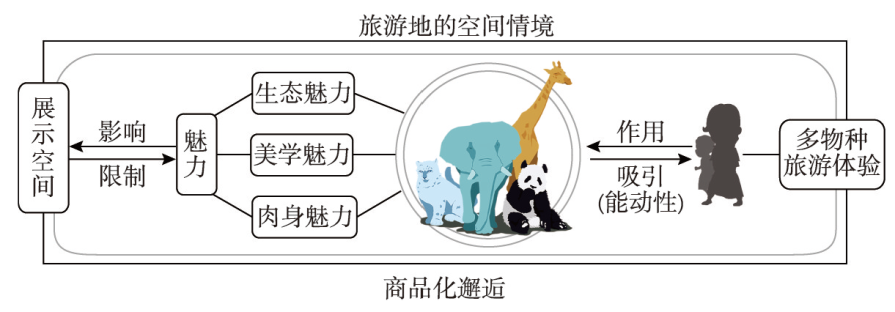

游客与旅游地明星动物商品化的邂逅研究——以四川大熊猫基地为例
|
尹铎(1990-), 男, 内蒙古鄂尔多斯人, 博士, 副教授, 硕士生导师, 研究方向为旅游地理与社会文化地理。E-mail: yinduo@gzhu.edu.cn |
收稿日期: 2022-11-07
修回日期: 2023-07-09
网络出版日期: 2024-02-01
基金资助
国家自然科学基金项目(42142025)
国家自然科学基金项目(41971184)
Commoditized encounter between visitors and star animals in tourist destinations: A case study of Sichuan giant panda bases
Received date: 2022-11-07
Revised date: 2023-07-09
Online published: 2024-02-01
Supported by
National Natural Science Foundation of China(42142025)
National Natural Science Foundation of China(41971184)
人与动物的互动实践已成为人文地理学者探索人地关系的重要研究议题。以四川大熊猫基地为案例,基于“魅力”概念,运用深度访谈、参与式观察与文本分析的方法,深入分析游客与明星动物在旅游活动中的邂逅,并揭示在此旅游过程中动物的能动性发挥与游客的多物种间的旅游体验。研究发现,游客与大熊猫的邂逅发生在不同空间情境下,其多样性是旅游地设计并刻意安排的商品化结果。大熊猫的魅力之于差异化的空间情境往往具有不同的影响作用。具体而言:① 在实体展示空间的“前台”中,大熊猫的生态魅力与美学魅力能够激发游客观览时的天然好感,旅游地对其进行利用以维持大熊猫旅游的不竭热度;② 旅游地所构建的虚拟展示空间则提供了无法直接观览到的大熊猫生物学特征与生命历程,使游客与大熊猫邂逅形式得以补充与丰富;③ 而在实体展示空间的“后台”中,旅游与公益教育相结合,游客被允许接近大熊猫的生活空间,建立起基于肉身魅力的更深层次的亲密邂逅。总体看,大熊猫的魅力不仅塑造了游客的多物种间的旅游体验,而且还构建了游客对于四川的地方认同。研究以空间视角探究了人与动物互动所营建的关系网络及其映射的权力运作机制,为探索旅游情境下的人与动物关系提供了新尝试,也为理解地球生命共同体提供了来自地理学的解析。

尹铎 , 卢薇 , 朱竑 . 游客与旅游地明星动物商品化的邂逅研究——以四川大熊猫基地为例[J]. 地理学报, 2024 , 79(2) : 534 -548 . DOI: 10.11821/dlxb202402015
Recently, studying the interaction between human and animals has become an important way for human geographers to explore the relationship between society and nature. By adopting qualitative research methods such as in-depth interviews, participatory observation, and text analysis, this paper analyzes encounters of visitors and star animals in Sichuan giant panda bases. It reveals animal agencies and multi-species tourism experiences based on the concept of nonhuman charisma. This research found various encounters between visitors and wild animals, and these diversities are specifically designed, which has variegated effects. Specifically, (1) in the "foreground" of the physical space of the tourist destination, the panda's ecological and aesthetic charisma can arouse natural goodwill among tourists, which is manipulated by the tourist destination to maintain popularity to panda tourism; (2) the virtual space constructed by tourist destinations provides biological characteristics and life course of panda that cannot be directly observed, thus complementing and enriching the encounters between visitors and panda; (3) the "backstage" of the physical space of the tourist destination combines tourism with public welfare in volunteer activities, allows tourists to enter the living space of the pandas and thus shapes deeper and more intimate encounters based on panda's charm of the flesh. In general, the charisma of pandas not only shapes tourists' multi-species tourism experience, but also constructs tourists' place identity with Sichuan. The research explores the relationship network constructed by human animal interaction and the power operation mechanism mapped from a spatial perspective, which provides a new attempt to explore the relationship between humans and animals in tourism and reflects the construction of community of all life on earth from a geographical lens.

Key words: wildlife tourist destination; agency; place; encounter; giant panda; Sichuan
| [1] |
[汤茂林, 陆玭, 刘茂松. 统一地理学发展之道: 直面危机, 加强对话, 超越自然—人文二元化. 热带地理, 2010, 30(2): 101-106.]
|
| [2] |
[顾朝林. 当代地理学新进展. 中学地理教学参考, 2022(13): 30-33.]
|
| [3] |
[理查德·哈特向. 地理学性质的透视. 黎樵, 译. 北京: 商务印书馆, 1963.]
|
| [4] |
|
| [5] |
|
| [6] |
[蔡晓梅, 刘美新. 后结构主义背景下关系地理学的研究进展. 地理学报, 2019, 74(08): 1680-1694.]
|
| [7] |
[卢薇, 尹铎, 朱竑. 西方超越人类的地理学研究进展. 地理学报, 2019, 74(10): 2178-2191.]
|
| [8] |
|
| [9] |
|
| [10] |
|
| [11] |
|
| [12] |
[崔庆明, 徐红罡. 野象的迷思: 野象谷人—象冲突的社会建构分析. 旅游学刊, 2012, 27(5): 49-56.]
|
| [13] |
[丛丽, 吴必虎, 张玉钧, 等. 野生动物旅游场所涉入实证分析: 以澳大利亚班布里海豚探索中心为例. 北京大学学报(自然科学版), 2017, 53(4): 715-721.]
|
| [14] |
|
| [15] |
[甘霖. 中国红嘴鸥中单增李斯特菌及野生啮齿动物中伊氏李斯特菌的研究[D]. 北京: 中国疾病预防控制中心, 2020.]
|
| [16] |
[尹铎, 高权, 朱竑. 广州鳄鱼公园野生动物旅游中的生命权力运作. 地理学报, 2017, 72(10): 1872-1885.]
|
| [17] |
|
| [18] |
|
| [19] |
|
| [20] |
[费尔南多J. 博斯科. 行动者网络: 理论、网络和关系方法在人文地理学中的应用//斯图尔特·艾特肯, 吉尔·瓦伦丁. 人文地理学方法. 柴彦威, 周尚意, 等, 译. 北京: 商务印书馆, 2016: 139-142.]
|
| [21] |
|
| [22] |
|
| [23] |
|
| [24] |
|
| [25] |
|
| [26] |
[窦东徽, 刘肖岑, 张玉洁. 娃娃脸效应: 对婴儿面孔的偏好及过度泛化. 心理科学进展, 2014, 22(5): 760-771.]
|
| [27] |
|
| [28] |
|
| [29] |
|
| [30] |
|
| [31] |
|
| [32] |
|
| [33] |
[潘文石. 熊猫虎子. 南宁: 广西师范大学出版社, 2005.]
|
| [34] |
|
| [35] |
|
| [36] |
|
| [37] |
|
| [38] |
|
| [39] |
[奉永友, 李鸣, 黄祥明, 等. 圈养大熊猫个性与应激反应研究进展. 野生动物学报, 2022, 43(1): 210-214.]
|
| [40] |
|
/
| 〈 |
|
〉 |